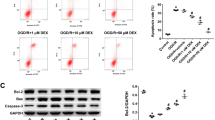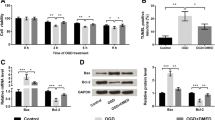Summary
Dexmedetomidine (DEX), a potent and highly selective agonist for α2-adrenergic receptors (α2AR), exerts neuroprotective effects by reducing apoptosis through decreased neuronal Ca2+ influx. However, the exact action mechanism of DEX and its effects on oxygen-glucose deprivation-reoxygenation (OGD/R) injury in vitro are unknown. We demonstrate that DEX pretreatment reduced OGD/R injury in PC12 cells, as evidenced by decreased oxidative stress, autophagy, and neuronal apoptosis. Specifically, DEX pretreatment decreased the expression levels of stromal interaction molecule 1 (STIM1) and calcium release-activated calcium channel protein 1 (Orai1), and reduced the concentration of intracellular calcium pools. In addition, variations in cytosolic calcium concentration altered apoptosis rate of PC12 cells after exposure to hypoxic conditions, which were modulated through STIM1/Orai1 signaling. Moreover, DEX pretreatment decreased the expression levels of Beclin-1 and microtubule-associated protein 1A/1B-light chain 3 (LC3), hallmark markers of autophagy, and the formation of autophagosomes. In conclusion, these results suggested that DEX exerts neuroprotective effects against oxidative stress, autophagy, and neuronal apoptosis after OGD/R injury via modulation of Ca2+-STIM1/Orai1 signaling. Our results offer insights into the molecular mechanisms of DEX in protecting against neuronal ischemia-reperfusion injury.
Similar content being viewed by others
References
Eggers C, Fujitani M, Kato R, et al. Novel cannabis flavonoid, cannflavin A displays both a hormetic and neuroprotective profile against amyloid betamediated neurotoxicity in PC12 cells: comparison with geranylated flavonoids, mimulone and diplacone. Biochem Pharmacol, 2019,169:113609
Liu S, Yu G, Song G, Zhang Q. Green tea polyphenols protect PC12 cells against H2O2-induced damages by upregulating lncRNA MALAT1. Int J Immunopathol Pharmacol, 2019,33:2058738419872624
Zhao HY, Zhang ST, Cheng X, et al. Long non-coding RNA GAS5 promotes PC12 cells differentiation into Tuj1-positive neuron-like cells and induces cell cycle arrest. Neural Regen Res, 2019,14(12):2118–2125
Qiu T, He YY, Zhang X, et al. Novel Role of ER Stress and Mitochondria Stress in Serum-deprivation Induced Apoptosis of Rat Mesenchymal Stem Cells. Curr Med Sci, 2018,38(2):229–235
Roos J, Di Gregorio PJ, Yeromin AV, et al. STIM1, an essential and conserved component of store-operated Ca2+ channel function. J Cell Biol, 2005,169(3):435–445
Prakriya M, Feske S, Gwack Y, et al. Orail is an essential pore subunit of the CRAC channel. Nature, 2006,443(7108):230–233
Yao JH, Liu ZJ, Yi JH, et al. Hepatitis B Virus X Protein Upregulates Intracellular Calcium Signaling by Binding C-terminal of Orail Protein. Curr Med Sci, 2018,38(1):26–34
Ahsan A, Zheng YR, Wu XL, et al. Urolithin A-activated autophagy but not mitophagy protects against ischemic neuronal injury by inhibiting ER stress in vitro and in vivo. CNS Neurosci Ther, 2019,25(9):976–986
Zhou Z, Xu H, Liu B, et al. Suppression of lncRNA RMRP ameliorates oxygen-glucose deprivation/reoxygenation-induced neural cells injury by inhibiting autophagy and PI3K/Akt/mTOR-mediated apoptosis. Biosci Rep, 2019,39(6):BSR20181367
Tang C, Huang X, Kang F, et al. Intranasal Dexmedetomidine on Stress Hormones, Inflammatory Markers, and Postoperative Analgesia after Functional Endoscopic Sinus Surgery. Mediators Inflamm, 2015,2015:939431
Tang C, Xia Z. Dexmedetomidine in perioperative acute pain management: a non-opioid adjuvant analgesic. J Pain Res, 2017,10:1899–1904
Wu L, Zhao H, Weng H, Ma D. Lasting effects of general anesthetics on the brain in the young and elderly: “mixed picture” of neurotoxicity, neuroprotection and cognitive impairment. J Anesth, 2019,33(2):321–335
Dupuis S, Brindamour D, Karzon S, et al. A systematic review of interventions to facilitate extubation in patients difficult-to-wean due to delirium, agitation, or anxiety and a meta-analysis of the effect of dexmedetomidine. Can J Anaesth, 2019,66(3):318–327
Kang F, Tang C, Han M, et al. Effects of Dexmedetomidine-Isoflurane versus Isoflurane Anesthesia on Brain Injury After Cardiac Valve Replacement Surgery. J Cardiothorac Vasc Anesth, 2017,32(4):1581–1586
Tang C, Chai X, Kang F, et al. I-gel Laryngeal Mask Airway Combined with Tracheal Intubation Attenuate Systemic Stress Response in Patients Undergoing Posterior Fossa Surgery. Mediators Inflamm, 2015,2015:965925
Dong CJ, Guo Y, Wheeler L, et al. Alpha2 adrenergic receptor-mediated modulation of cytosolic Ca++ signals at the inner plexiform layer of the rat retina. Invest Ophthalmol Vis Sci, 2007,48(3):1410–1415
Sun Y, Zhu Y, Zhong X, et al. Crosstalk Between Autophagy and Cerebral Ischemia. Front Neurosci, 2018,12:1022
Raghubir R, Nakka VP, Mehta SL. Endoplasmic reticulum stress in brain damage. Methods Enzymol, 2011,489:259–275
Schroder M, Kaufman RJ. ER stress and the unfolded protein response. Mutat Res, 2005,569(1–2):29–63
Xu C, Bailly-Maitre B, Reed JC. Endoplasmic reticulum stress: cell life and death decisions. J Clin Invest, 2005,115(10):2656–2664
Menei P, Pean JM, Nerriere-Daguin V, et al. Intracerebral implantation of NGF-releasing biodegradable microspheres protects striatum against excitotoxic damage. Exp Neurol, 2000,161(1):259–272
Shimoke K, Chiba H. Nerve growth factor prevents 1-methyl-4-phenyl-1,2,3,6-tetrahydropyridine-induced cell death via the Akt pathway by suppressing caspase-3-like activity using PC12 cells: relevance to therapeutical application for Parkinson’s disease. J Neurosci Res, 2001,63(5):402–409
Troy CM, Rabacchi SA, Xu Z, et al. beta-Amyloid-induced neuronal apoptosis requires c-Jun N-terminal kinase activation. J Neurochem, 2001,77(1):157–164
Rao W, Zhang L, Su N, et al. Blockade of SOCE protects HT22 cells from hydrogen peroxide-induced apoptosis. Biochem Biophys Res Commun, 2013,441(2):351–356
Zhang C, Thomas DW. Stromal Interaction Molecule 1 rescues store-operated calcium entry and protects NG115–401L cells against cell death induced by endoplasmic reticulum and mitochondrial oxidative stress. Neurochem Int, 2016,97:137–145
Zhao B, Yuan Q, Hou JB, et al. Inhibition of HDAC3 Ameliorates Cerebral Ischemia Reperfusion Injury in Diabetic Mice In Vivo and In Vitro. J Diabetes Res, 2019,2019:8520856
Schleicher SM, Moretti L, Varki V, et al. Progress in the unraveling of the endoplasmic reticulum stress/autophagy pathway and cancer: implications for future therapeutic approaches. Drug Resist Updat, 2010,13(3):79–86
Norberg E, Gogvadze V, Ott M, et al. An increase in intracellular Ca2+ is required for the activation of mitochondrial calpain to release AIF during cell death. Cell Death Differ, 2008,15(12):1857–1864
Joza N, Susin SA, Daugas E, et al. Essential role of the mitochondrial apoptosis-inducing factor in programmed cell death. Nature, 2001,410(6828):549–554
Orrenius S, Nicotera P, Zhivotovsky B. Cell death mechanisms and their implications in toxicology. Toxicol Sci, 2011,119(1):3–19
Wang SH, Shih YL, Ko WC, et al. Cadmium-induced autophagy and apoptosis are mediated by a calcium signaling pathway. Cell Mol Life Sci, 2008,65(22):3640–3652
Buytaert E, Callewaert G, Hendrickx N, et al. Role of endoplasmic reticulum depletion and multidomain proapoptotic BAX and BAK proteins in shaping cell death after hypericin-mediated photodynamic therapy. FASEB J, 2006,20(6):756–758
Hoyer-Hansen M, Bastholm L, Szyniarowski P, et al. Control of macroautophagy by calcium, calmodulin-dependent kinase kinase-beta, and Bcl-2. Mol Cell, 2007,25(2):193–205
Hoyer-Hansen M, Jaattela M. Connecting endoplasmic reticulum stress to autophagy by unfolded protein response and calcium. Cell Death Differ, 2007,14(9):1576–1582
Gu J, Dai S, Liu Y, et al. Activation of Ca(2+)-sensing receptor as a protective pathway to reduce Cadmium-induced cytotoxicity in renal proximal tubular cells. Sci Rep, 2018,8(1):1092
Holen I, Gordon PB, Stromhaug PE, et al. Role of cAMP in the regulation of hepatocytic autophagy. Eur J Biochem, 1996,236(1):163–170
Parys JB, Decuypere JP, Bultynck G. Role of the inositol 1,4,5-trisphosphate receptor/Ca2+-release channel in autophagy. Cell Commun Signal, 2012,10(1):17
Pushparaj C, Das A, Purroy R, et al. Voltage-gated calcium channel blockers deregulate macroautophagy in cardiomyocytes. Int J Biochem Cell Biol, 2015,68:166–175
Vicencio JM, Lavandero S, Szabadkai G. Ca2+, autophagy and protein degradation: thrown off balance in neurodegenerative disease. Cell Calcium, 2010,47(2):112–121
Singhal J, Agrawal N, Vashishta M, et al. Suppression of dendritic cell-mediated responses by genes in calcium and cysteine protease pathways during Mycobacterium tuberculosis infection. J Biol Chem, 2012,287(14):11108–11121
Yoshikawa Y, Hirata N, Terada H, et al. Identification of Candidate Genes and Pathways in Dexmedetomidine-Induced Cardioprotection in the Rat Heart by Bioinformatics Analysis. Int J Mol Sci, 2019,20(7)
Wu GJ, Chen JT, Tsai HC, et al. Protection of Dexmedetomidine Against Ischemia/Reperfusion-Induced Apoptotic Insults to Neuronal Cells Occurs Via an Intrinsic Mitochondria-Dependent Pathway. J Cell Biochem, 2017,118(9):2635–2644
Tang CL, Li J, Zhang ZT, et al. Neuroprotective effect of bispectral index-guided fast-track anesthesia using sevoflurane combined with dexmedetomidine for intracranial aneurysm embolization. Neural Regen Res, 2018,13(2):280–288
Zhu Y, Li S, Liu J, et al. Role of JNK Signaling Pathway in Dexmedetomidine Post-Conditioning-Induced Reduction of the Inflammatory Response and Autophagy Effect of Focal Cerebral Ischemia Reperfusion Injury in Rats. Inflammation, 2019,42(6):2181–2191
Jiang L, Hu M, Lu Y, et al. The protective effects of dexmedetomidine on ischemic brain injury: A meta-analysis. J Clin Anesth, 2017,40:25–32
Acknowledgement
The authors are grateful for the enthusiastic support of Mr. Kai Zhang’s contribution to design the graphics.
Author information
Authors and Affiliations
Corresponding author
Ethics declarations
The authors declare that there is no conflict of interest regarding the publication of this article.
Additional information
This study was supported by grants from the National Natural Science Foundation of China (No. 81801175 and No. 81970722), the Fundamental Research Funds for the Central Universities (No. WK9110000044 and No. WK9110000036), China Scholarship Council (No. 201706270155), the China Postdoctoral Science Foundation (No. 2019M662179), and the Anhui Province Postdoctoral Science Foundation (No. 2019B324).
Rights and permissions
About this article
Cite this article
Hu, Yd., Tang, Cl., Jiang, Jz. et al. Neuroprotective Effects of Dexmedetomidine Preconditioning on Oxygen-glucose Deprivation-reoxygenation Injury in PC12 Cells via Regulation of Ca2+-STIM1/Orai1 Signaling. CURR MED SCI 40, 699–707 (2020). https://doi.org/10.1007/s11596-020-2201-5
Received:
Accepted:
Published:
Issue Date:
DOI: https://doi.org/10.1007/s11596-020-2201-5




